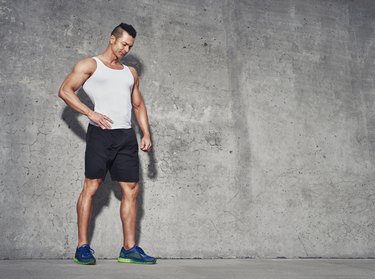
In physics, density is defined as an object's mass divided by its volume. Body density is essentially your compactness, or how much you weigh for every square inch of space you take up. Knowing your total body density can be helpful if you plan to use it in equations that help you estimate percent body fat. Your body fat can have a direct impact on your health because excess fat puts you at risk for problems that include type-2 diabetes and heart disease. You can figure body density using direct measurements of your body weight and volume, measured using water or air displacement.
Density of Body Fat
Video of the Day
A person's body density depends on how much fat and fat-free mass he carries. Fat is found under the skin, around the internal organs, as an essential part of the central nervous system, as part of the structure of some internal organs and inside the bone marrow. The density of fat is fairly consistent at 0.91 kilogram per liter and is less dense that most of your fat-free mass.
Video of the Day
When you know your total body density, you still don't know what percentage of it is fat. But you can plug your body density into the following equation to get a general idea: percent body fat = (495 / Body Density) - 450.
Density of Fat-Free Mass
Fat-free mass consists of bone, fluid, gas, muscle, connective tissue and nonfatty organ matter. Fat-free tissue generally has a greater density than fat mass -- 1.1 kilograms per liter for the average, middle-aged adult. The actual density of fat-free mass varies from person to person, depending on race, age and fitness level. For example, African-Americans and Hispanics have denser fat-free mass than whites. In children and older adults, the density of fat-free mass is usually lower than this average estimate in middle-aged adults.
Each of the components of fat free mass also has different densities, and some, such as fluid and gas, can vary from day to day. Some tests that provide a measure of body density, such as hydrostatic weighing, require you to exhale completely while being measured. This helps ensure the lighter density of gas in your lungs doesn't skew your measurement.
Figuring Body Density With Underwater Weighing
Density is easy to measure in a regularly formed object, such as a cube. You weigh it to determine its mass and then determine volume by figuring the length of a side cubed -- so volume = side x side x side. Density then equals mass / volume.
Figuring human density is a little trickier. Body weight, or mass, can easily be found using a scale. Computing volume is more difficult because the body is an irregularly-shaped object. Volume can be measured by submerging your body in water and measuring this underwater weight. The difference in the underwater weight and your dry-land weight is equal to the amount of water displaced. Because the density of water is a known scientific fact, you can then calculate the volume of the water displaced and from this you know the volume of your body. Body density is then determined by dividing your dry land weight by your body's volume.
Bone and muscle -- primary components of fat-free mass -- are denser than water; so muscular people with low body fat levels tend to sink. Fat floats, so a person with a lot of fat mass will measure lighter in the water. If performed accurately, underwater weighing has just a 1.5 percent standard of error.
Air Displacement Method of Determining Body Density
You can also use a large commercial machine called the Bod Pod to determine your body density. It uses whole-body air-displacement plethysmography, or air displacement, to do the calculation. The volume of air in the pod when it's empty is first figured. Then the machine measures the volume of air in the chamber with you inside. The difference between the two measures is the body's volume. An equation then computes body density using this volume and the person's scale weight. The Bod Pod also plugs body density into an equation to determine body fat levels. Air displacement provides a 3 percent standard of error.
Equations to Figure Body Density
Several mathematical equations can also help determine body density. They use measurements of skin folds -- acquired with body calipers that pinch the skin at certain sites to estimate the amount of subcutaneous, or under-the-skin, fat -- along with waist circumference, age and gender to figure body density. All of these equations are quite involved, but their ultimate goal is to use body density to come up with a person's body fat level. The accuracy of these equations varies when applied to the general population.
- Top End Sports: Measuring Body Density
- Georgia State University: Body Composition
- Top End Sports: Hydrostatic Weighing
- USDA/ARS Children's Nutrition Research Center: Densitometry Theory
- Top End Sports: Whole-Body Air-Displacement Plethysmography
- Archives of Diseases in Childhood: Measuring Body Composition
- Exercise Physiology: Nutrition, Energy, and Human Performance; William D. McArdle et al.
- Journal of Applied Physiology: Density of the Fat-Free Mass and Estimates of Body Composition in Male Weight Trainers
- International Journal of Obesity and Related Metabolic Disorders: Adipose Tissue Density, Estimated Adipose Lipid Fraction and Whole Body Adiposity in Male Cadavers
- Top End Sports: Percentage Bodyfat